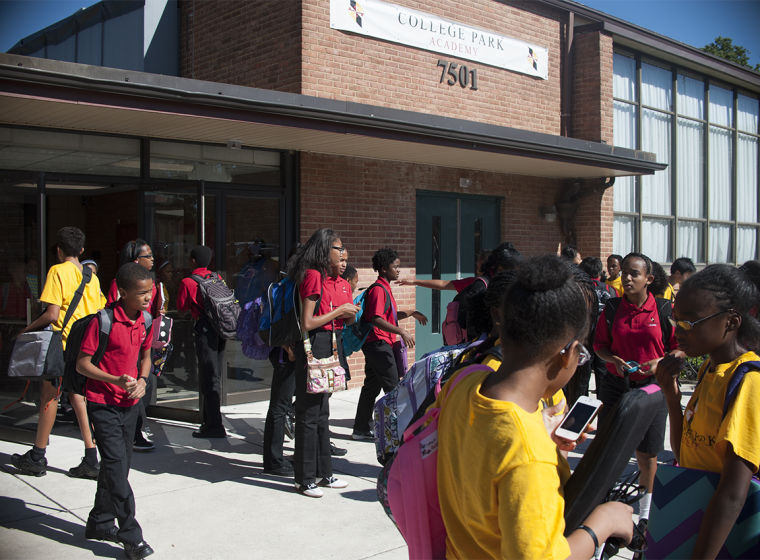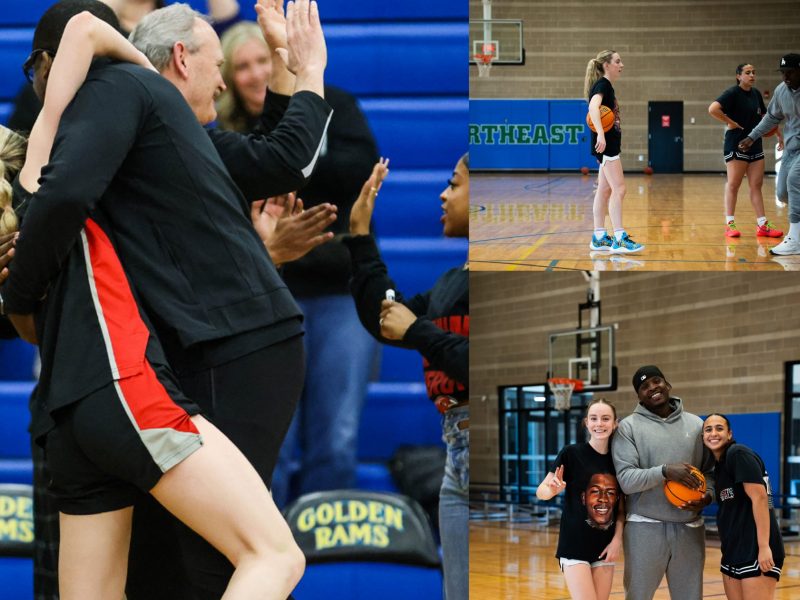
College Park Academy, a charter school in Hyattsville, offers an individualized curriculum that lets students earn up to 60 college credits online.
The bell rang, and they filed in with their zebra-print lunch boxes, oversized backpacks and neon Converse shoes. In a high-ceilinged room next to a wall of windows, they sat chatting at high round tables or individual cubbies. Then they opened their laptops and got to work.
Teachers from around the world appeared on the students’ computer screens. Class had begun.
For the 300 new sixth- and seventh-grade students at College Park Academy, a new charter school temporarily situated at the former site of St. Mark the Evangelist School in Hyattsville, it was back to school of a different kind when the doors opened Aug. 19. Two years in the making, the school offers an academically rigorous curriculum and the opportunity to take college classes early and learn in an individualized, and sometimes online, environment.
The school’s opening marks the birth of the largest public charter school in the country using such a curriculum system, administrators said. It’s the result of years of work from university President Wallace Loh, the Student Government Association, the city of College Park and the education college. As part of Loh’s “2020 vision” — his goal to help the university improve its reputation and make College Park a top-20 college town by 2020 — officials involved with the academy hope its opening will draw more faculty members to live in the city.
“You have a very highly educated population at UMD — it would be nice for professors to live near the college and collaborate and participate in the surrounding community,” said Marcy Cathey, executive director of the academy. “But because there aren’t more professors who live in the city of College Park, there wasn’t the same match for rigor in area schools. So the idea is to create this vibrant alternative.”
At College Park Academy, which, as students age, will eventually include classes through 12th grade, students can earn up to 60 credits online from any accredited college or university in the world, 25 of which can come from this university.
In the large, airy “team room,” students work at their own pace, learning online with the help of “success coaches” walking around the room to supervise students’ progress. Students study subjects from algebra and English to languages such as Mandarin Chinese, Spanish, French, German, Latin, Japanese and American Sign Language. In each classroom, whether it’s in the blended learning environment of the team room or a traditional classroom, they work at their own paces.
“You take an assessment which gives you immediate feedback, and then you move onto the next topic,” Cathey said. “So you’re not waiting for someone else to get it or for the chapter test at the end of the week. … And if you get to a topic that doesn’t come as easily to you, you can take the time to learn the topic thoroughly before moving on to the next one.”
In an increasingly digital world, success coach Heather Jackson, said learning in a traditional “brick-and-mortar” classroom just doesn’t make the cut anymore.
“In a traditional classroom, there’s a lot of artificial structure imposed. You reach the end of what’s offered at the school and you’re done — there’s not much beyond that. You get to AP and you’re done,” she said. “That’s not an issue here.”
Several of her students are already “flying through” their algebra classes, Jackson said, enabling themselves to move on before the year is over and put themselves ahead for success in STEM fields.
And so far, Jackson said, the kids seem to like the individualism. At the end of the first week, she asked her students to write down three aspects of the school they liked and three they didn’t.
Dislikes included, “I wish we had a longer recess; I wish lunch was longer,” Jackson said, laughing. “But the things that they really liked: They liked working at their own pace. They liked having the flexibility to choose what they’re working on in a given day. If they’re really in the zone on math, they could just keep going on math that day — they didn’t have to switch when the bell rings.
“They’re digging in, and they’re adapting really well,” she said.
Located so close to each other, the academy and the university plan to develop a mutually beneficial partnership that will eventually include student interns, student groups’ collaboration on after-school activities, department research and more.
During the second half of Tehani Collazo’s course — EDCI 210: Exploring Teaching as a Career — this semester, about 15 university students will intern at the academy, working in the team room, traditional classrooms or after-school programs. Students will work four hours a week and develop their own “projects” to teach the children.
“For some, it’s ‘How do you support middle school students learning in an online curriculum?’” Collazo said. “For others, it’s ‘How do you support students playing ultimate Frisbee?’”
If everything goes well this semester, Collazo will also teach her course in the spring.
Collazo’s course is just the beginning of a potentially enriching partnership, said Liz Pandya, senior government and politics major and former SGA student affairs vice president. In mid-October, all 300 academy students will tour the university and participate in roundtable discussions with different departments.
Later this semester, the SGA plans to establish an advisory committee between the schools, allowing university students interested in education politics to play a role. Architecture students will also work with academy students on a project to develop an outdoor classroom at the academy, and journalism and government and politics students may collaborate with the younger students to create a student newspaper and a student government, Pandya said.
Beyond the formal partnerships, Bernadette Ortiz-Brewster, the academy’s principal, is most excited for the simple conversations between the college students and middle and high school students.
The younger students might ask the older ones, “‘Oh, so what are you studying? How did you get there? How do you become an engineer? Or, how do you become an educator?’” Ortiz-Brewster said. “And I think there’s a huge value on that. We want them to be able to see themselves in the future and say ‘Oh, I can be that as well.’”
Moving kids from traditional group learning styles to an individualized blended-learning environment is not without its challenges, academy officials said. The strategies include teaching kids to stay focused on their computers and work diligently without a teacher’s constant coaching.
And the school has dealt with its own share of logistical issues within the past few weeks, including an Internet crash when students initially received their laptops, said Donna Wiseman, education college dean.
“It’s a new school; there’s some bumps and glitches,” she said. “But there’s also so much excitement when you walk into the hallway, and kids are excited to be there.”
On Wednesday morning, as students walked through the hallways switching classes, the excitement was palpable. Students laughed and chattered, carrying books and snacks, some adorning their plain uniforms with sequined accessories.
Outside, the shrubs are pruned, the flowers weeded. The morning sun lit up the glass doors, where a modest paper sign spelled out the school’s name.
The students might be blazing trails through traditional academia, but on Wednesday, they already seemed right at home.
And if the innovative blend of online and individual instruction works for the middle-schoolers, maybe the idea can spread to the university, Wiseman said.
“If it works out in a school like this, why wouldn’t it work in our own campus?” Wiseman said. “If these kids are learning in sixth grade and go all the way through and get into UMD, are they going to want to go back to traditional learning?
“I just think it’s exciting and an opportunity for us all to get involved,” she said.



